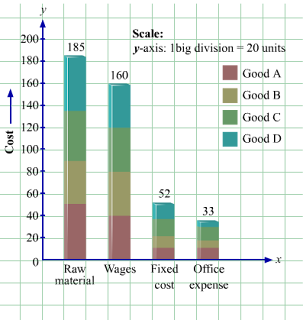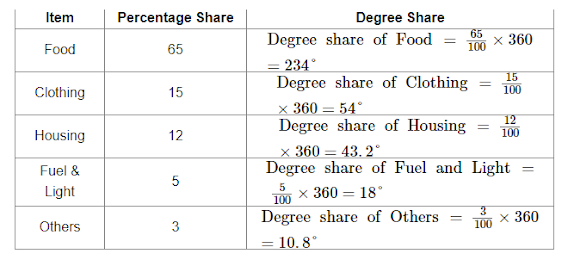PROGRAM:
DIPLOMA IN COMPUTER ENGINEERING
/ DIPLOMA IN IT
STATISTICS AND PROBABILITY
MATHEMATICS
2 YEAR // 2 PART
Pictorial Representation Of a Data Set: –
Bar Diagrams,Pie(circular,angular) Diagrams ,Histogram And Polygon And Ogive
Question 1:
Get information from your school office about the HSEB result (2018) for the students of Class XII in your school. Draw a bar diagram (showing their aggregate marks classified as 1st division, 2nd division and 3rd division).
ANSWER:
Question 1:
Check your school records on admissions. See how many students were admitted every year during the last 10 years. Classify the data as male and female students. Present the data in the form of a multiple bar diagram.
|
Year |
2003−04 |
2004−05 |
2005−06 |
2006−07 |
2007−08 |
2008−09 |
2009−10 |
2010−11 |
2011−12 |
2012−13 |
|
Male |
40 |
50 |
60 |
45 |
50 |
90 |
65 |
70 |
75 |
80 |
|
Female |
50 |
30 |
70 |
50 |
50 |
50 |
45 |
80 |
80 |
90 |
Question 2:
Make a multiple bar diagram of the following data:
| Faculty | Number of Students | ||
| 2015-16 | 2016-17 | 2017-18 | |
| Arts Science Commerce | 600 400 200 | 550 500 250 | 500 600 |
TYPE 3: sub-divided bar diagram
Question 1:
Following table shows estimates of cost of production of certain commodities. Present the data in the form of a sub-divided bar diagram:
| Estimate of Cost | Goods | |||
| A | B | C | D | |
| Raw materia Wages Fixed Costs Office expenses | 50 40 10 10 | 40 40 12 8 | 45 40 15 10 | 50 40 15 5 |
| Total Cost | 110 | 100 | 110 | 110 |
ANSWER:
|
Goods |
|||||
|
Estimates |
A |
B |
C |
D |
Total |
|
Raw Materials |
50 |
40 |
45 |
50 |
185 |
Question 2:
Present the following data on the production of food grains in the form of a sub-divided bar diagram:
| Year | Wheat | Rice | Gram | Total |
| 2017 2018 | 30 45 | 20 30 | 10 15 | 60 90 |
|
Year |
Wheat |
Rice |
Grain |
Total |
|
2017 |
30 |
20 |
10 |
60 |
|
2018 |
45 |
30 |
15 |
90 |
Type: 4 pie/circular/angular diagram.
Question 1:
Waht do you mean by a circular diagram? Present the data on the expenditure of a labour-family in the form of a circular diagram:(similar question ask in 2074 shrawan/bhadra Q.12)
| Items of Expenditure | Food | Clothing | Housing | Fuel and Light | Others |
| Percentage of Income Spent | 65 | 15 | 12 | 5 | 3 |
For presenting the given percentage values in a pie diagram, the percentage values must be converted into the respective degree values, for which the following formula is used.
Question 2:
For the years 2012-13 and 2013-14, value of gross domestic product at factor cost by the industry of origin is given in the following table. Present the information in the form of Pie Diagram showing differences in the percentage contribution of different sectors between the said years.| Sector | Year | |
| 2012-13 | 2013-14 | |
| Primary Secondary Tertiary | 17 57 26 | 16.7 26 57.3 |
| Total | 100 | 100 |
Question 1:
Visit different schools in your locality. Collect information on the daily wage earners. Your information should include (i) daily earnings, and (ii) number of wage earners. Convert the raw data in to a continuous frequency distribution, and present your information in the form a histogram.
Answer:
| Daily Earnings | Number of wage earners |
| 0−20 20−40 40−60 60−80 80−100 | 37 50 70 25 10 |
Construct histogram, frequency polygon and frequency curve from the following data:
Similar to a frequency polygon, for drawing a frequency curve we again joint the top mid-points of the rectangles of the histogram drawn in the first part, but with a free hand
Question 3:
Make a histogram and frequency polygon using the given data:
(similar question ask in 2073/2077/2078-2079 )
| Marks Obtained | 10−20 | 20−30 | 30−40 | 40−50 | 50−60 | 60−70 |
| Number of Students | 5 | 12 | 15 | 22 | 14 | 4 |
Question 4 (Important)
Graph the following data in the form of 'less than' and 'more than' ogives; and calculate the median value through the graph: (similar question ask in 2074/2076 )
| Marks | 0−5 | 5−10 | 10−15 | 15−20 | 20−25 | 25−30 | 30−35 | 35−40 |
| Number of Students | 7 | 10 | 20 | 13 | 17 | 10 | 14 | 9 |
ANSWER:
Less than and More than Ogive
| Marks | Cumulative Frequency |
| Less than 5 Less than 10 Less than 15 Less than 20 Less than 25 Less than 30 Less than 35 Less than 40 | 7 7 + 10 = 17 17 + 20 = 37 37 + 13 = 50 50 + 17 = 67 67 + 10 = 77 77 + 14 = 91 91 + 9 = 100 |
|
Marks |
Cumulative
Frequency |
|
More than 0 |
100 |
|
More than 5 |
100 − 7 = 93 |
|
More than 10 |
93 − 10 = 83 |
|
More than 15 |
83 − 20 = 63 |
|
More than 20 |
63 − 13 = 50 |
|
More than 25 |
50 − 17 = 33 |
|
More than 30 |
33 − 10 = 23 |
|
More than 35 |
23 − 14 = 9 |
|
More than 40 |
9 − 9 = 0 |
So, median is 20.
Question 4
Draw 'less than' and 'more than' ogive curves from the following data:
and compute also median: (similar question ask in 2074/2076 )
| Marks | 0−10 | 10−20 | 20−30 | 30−40 | 40−50 |
| Number of Students | 5 | 10 | 14 | 10 | 3 |
| Marks | Cumulative Frequency |
| Less than 10 Less than 20 Less than 30 Less than 40 Less than 50 | 3 3 + 10 = 13 13 + 14 = 27 27 + 10 = 37 37 + 3 = 40 |
| Marks | Cumulative Frequency |
| More than 0 More than 10 More than 20 More than 30 More than 40 | 40 40 − 3 = 37 37 − 10 = 27 27 − 14 = 13 13 − 10 = 3 |
The point of intersection of the two types of ogives curves Gives the median.
i.e, The x co-ordinate of the point of intersection the o gives is the median
from figure, median=25
Question 4.0:
Draw 'less than' and 'more than' ogive curves from the following data:
| Marks | 0−5 | 5−10 | 10−15 | 15−20 | 20−25 | 25−30 | 30−35 | 35−40 |
| Number of Students | 7 | 10 | 20 | 13 | 12 | 19 | 14 | 9 |
(i) For constructing a less than ogive, first the given frequency distribution must be converted into a less than cumulative frequency distribution as follows.
| Marks | Cumulative Frequency |
| Less than 5 Less than 10 Less than 15 Less than 20 Less than 25 Less than 30 Less than 35 Less than 40 | 7 7 + 10 = 17 17 + 20 = 37 37 + 13 = 50 50 + 12 = 62 62 + 19 = 81 81 + 14 = 95 95 + 9 = 104 |
(ii) For constructing a less than ogive, first the given frequency distribution is converted into a more than cumulative frequency distribution as follows.
|
Marks |
Cumulative Frequency |
|
More than 0 |
104 |
|
|
104 − 7 = 97 |
|
More than 10 |
97 − 10 = 87 |
|
More than 15 |
87 − 20 = 67 |
|
More than 20 |
67 − 13 = 54 |
|
More than 25 |
54 − 12 = 42 |
|
More than 30 |
42 − 19 = 23 |
|
More than 35 |
23 − 14 = 9 |
|
More than 40 |
9 − 9 = 0 |
We now plot the cumulative frequencies against the lower limit of the class intervals. The curve obtained on joining the points so plotted is known as the more than ogive.
Question 5:
Represent the following data in the form of a histogram:
| Mid-point | 115 | 125 | 135 | 145 | 155 | 165 | 175 | 185 | 195 |
| Size | 6 | 55 | 48 | 72 | 116 | 60 | 38 | 22 | 3 |
![]()
The value obtained is then added to the mid point to obtain the upper limit and subtracted from the mid-point to obtain the lower limit.
For the given data, the class interval is calculated by the following value of adjustment.
Thus, we add and subtract 5 to each mid-point to obtain the class interval.
For instance:
The lower limit of first class = 115 – 5 = 110
Upper limit of first class = 115 + 5 = 120.
Thus, the first class interval is (110-120). Similarly, we can calculate the remaining class intervals.
|
Mid Point |
Class Interval |
Size |
|
115 |
110 − 120 |
6 |
|
125 |
120 − 130 |
55 |
|
135 |
130 − 140 |
48 |
|
145 |
140 − 150 |
72 |
|
155 |
150 − 160 |
116 |
|
165 |
160 − 170 |
60 |
|
175 |
170 − 180 |
38 |
|
185 |
180 − 190 |
22 |
|
195 |
190 − 200 |
3 |
Question 10:
The frequency distribution of marks obtained by students in a class test is given below. Draw frequency polygon(without histogram)
| Marks | 0−10 | 10−20 | 20−30 | 30−40 | 40−50 |
| Number of Students | 5 | 10 | 14 | 10 | 3 |
Question 11:(Importance)
Draw 'less than' as well as 'more than' ogives for the following data:
| Weight (in Kg) | 30−34 | 35−39 | 40−44 | 45−49 | 50−54 | 55−59 | 60−64 |
| Frequency | 3 | 5 | 12 | 18 | 14 | 6 | 2 |
Before proceeding to construct the ogives, we first need to convert the given inclusive series into an exclusive series using the following formula.
![]()
The value of adjustment as calculated is then added to the upper limit of each class and subtracted from the lower limit of each class.
Therefore, we add 0.5 to the upper limit and subtract 0.5 from the lower limit of each class.
| Weight | Frequency |
| 29.5 − 34.5 34.5 − 39.5 39.5 − 44.5 44.5 − 49.5 49.5 − 54.5 54.5 − 59.5 59.5 − 64.5 | 3 5 12 18 14 6 2 |
| Weight | Cumulative Frequency |
| Less than 34.5 Less than 39.5 Less than 44.5 Less than 49.5 Less than 54.5 Less than 59.5 Less than 64.5 | 3 3 + 5 = 8 8 + 12 = 20 20 + 18 = 38 38 + 14 = 52 52 + 6 = 58 58 + 2 = 60 |
| Weight | Cumulative Frequency |
| More than 0 More than 34.5 More than 39.5 More than 44.5 More than 49.5 More than 54.5 More than 59.5 More than 64.5 | 60 60 − 3 = 57 57 − 5 = 52 52 − 12 = 40 40 − 18 = 22 22 − 14 = 8 8 − 6 = 2 2 − 2 = 0 |
unit 5:
👉CENTERAL TENDENCY(MEAN,MEDIAN,MODE)
👉VARIABILITY OF DISPERSION(RANGE,INTER-QUARTILE RANGE,QUARTILE DEVIATION, QUARTILE,PERCENTILE,DECILE ,STANDARD DEVIATION,COFFICIENT OF VARIATION)
Question 1:
Calculate mode of the following series:
(similar question ask in 2077)
| Class Interval | 0−5 | 5−10 | 10−15 | 15−20 | 20−25 | 25−30 |
| Frequency | 20 | 24 | 32 | 28 | 20 | 26 |
| Class Interval | Frequency |
| 0 − 5 5 − 10 (l₁)10 − 15 15 − 20 20 − 25 25 − 30 | 20 24 f0 32 f1 28 f2 20 26 |
Question 2:Estimate quartile deviation(similar question ask in 2073)
and the coefficient of quartile deviation of the following data:
8, 9, 11, 12, 13, 17, 20, 21, 23, 25, 27
Show that QD is the average of the difference between two quartiles
Sr. No.
1
2
3
4
5
6
7
8
9
10
11
Data
8
9
11
12
13
17
20
21
23
25
27
In order to find the quartile deviation in case of individual series, find out the values of first quartile and third quartile using the following equations:
Q1 = Size of item
or, Q1 = Size of item
or, Q1 = Size of 3rd item
Q1 = 11
Q3 = Size of item
or, Q3 = Size of item
or, Q3 = Size of 9th item
Q3 = 23
8, 9, 11, 12, 13, 17, 20, 21, 23, 25, 27
Show that QD is the average of the difference between two quartiles
|
Sr. No. |
1 |
2 |
3 |
4 |
5 |
6 |
7 |
8 |
9 |
10 |
11 |
|
Data |
8 |
9 |
11 |
12 |
13 |
17 |
20 |
21 |
23 |
25 |
27 |
In order to find the quartile deviation in case of individual series, find out the values of first quartile and third quartile using the following equations:
Q1 = Size of itemor, Q1 = Size of item
or, Q1 = Size of 3rd item
Q1 = 11
Q3 = Size of item
or, Q3 = Size of item
or, Q3 = Size of 9th item
Q3 = 23
Question 2:
(similar question ask in 2078-79)
Find out mean deviation and its coefficient of the following data:
| Items | 5 | 10 | 15 | 20 | 25 | 30 | 35 | 40 |
| Frequency | 8 | 16 | 18 | 22 | 14 | 9 | 6 | 7 |
|
Items (X) |
Frequency (f) |
fX |
Deviation from Mean |
f∣dX∣ |
|
|
5 |
8 |
40 |
15.2 |
121.6 |
|
|
10 |
16 |
160 |
10.2 |
163.2 |
|
|
15 |
18 |
270 |
5.2 |
93.6 |
|
|
20 |
22 |
440 |
0.2 |
4.4 |
|
|
25 |
14 |
350 |
4.8 |
67.2 |
|
|
30 |
9 |
270 |
9.8 |
88.2 |
|
|
35 |
6 |
210 |
14.8 |
88.8 |
|
|
40 |
7 |
280 |
19.8 |
138.6 |
|
|
|
Σf = 100 |
Σfx = 2020 |
|
Σf∣dX∣=765.6 |
|
(b) Mean deviation from Arithmetic Mean
(c) Coefficient of
Question 3:
(similar question ask in 2077 Q.12)
Value
20-30
30-40
40-50
50-60
60-70
Frequency
8
24
42
20
6
|
Value |
20-30 |
30-40 |
40-50 |
50-60 |
60-70 |
|
Frequency |
8 |
24 |
42 |
20 |
6 |
Coefficient of Variation
= standard deviation.
= mean.
Comparison of C.V. of two data:
- Let assumed (C.V)1 and (C.V)2
👉 Less the C.V.,more will be uniformity, consistency,etc.
👉more the C.V., Less will be uniformity, consistency,etc.
👉The lower the value of the coefficient of variation, the more precise the estimate.
👉more the C.V., More will be variability,
👉 Example:An analysis of monthly
wages paid to the workers in two firm belonging to the same industry
Firm A Firm B
No. of workers: 600 700
Average monthly wage: Rs182.00
Rs178.50
Variance of
distribution of wage: 78 98
i)
Which firm A or B has a larger wage bill?
ii) In which firm A or
B is there greater variability in individual wages ?
give the
following results:
ANSWER:
(i) From the above results, form B has a larger wage bill.
(ii)Since the C.V. for firm B is greater than that of A, so
the distribution of wages
in firm B has greater variability.
= standard deviation.
= mean.
Comparison of C.V. of two data:
- Let assumed (C.V)1 and (C.V)2
👉 Less the C.V.,more will be uniformity, consistency,etc.
👉more the C.V., Less will be uniformity, consistency,etc.
👉The lower the value of the coefficient of variation, the more precise the estimate.
👉more the C.V., More will be variability,
👉 Example:An analysis of monthly wages paid to the workers in two firm belonging to the same industry
Firm A Firm B
No. of workers: 600 700
Average monthly wage: Rs182.00 Rs178.50
Variance of distribution of wage: 78 98
i) Which firm A or B has a larger wage bill?
ii) In which firm A or B is there greater variability in individual wages ?
give the following results:
ANSWER:
(i) From the above results, form B has a larger wage bill.
(ii)Since the C.V. for firm B is greater than that of A, so the distribution of wages
in firm B has greater variability.














.png)
.png)
.png)















